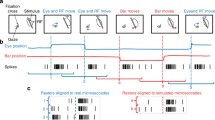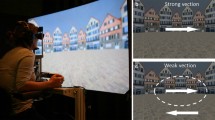Abstract
Eye movements are thought to account for a number of visual motion illusions involving stationary objects presented against a featureless background or apparent motion of the whole visual field. We tested two different versions of the eye movement account: (a) the retinal slip explanation and (b) the nystagmus-suppression explanation, in particular their ability to account for visual motion experienced during vibration of the neck muscles, and for the visual motion aftereffect following vibration. We vibrated the neck (ventral sternocleidomastoid muscles, bilaterally, or right dorsal muscles) and measured eye movements in conjunction with perceived illusory displacement of an LED presented in complete darkness (N=10). To test the retinal-slip explanation, we compared the direction of slow eye movements to the direction of illusory motion of the visual target. To test the suppression explanation, we estimated the direction of suppressed slow-phase eye movements and compared it to the direction of illusory motion. Two main findings show that neither actual nor suppressed eye movements cause the illusory motion and motion aftereffect. Firstly, eye movements do not reverse direction when the illusory motion reverses after vibration stops. Secondly, there are large individual differences with regards to the direction of eye movements in observers who all experience a similar visual illusion. We conclude that, rather than eye movements, a more global spatial constancy mechanism that takes into account head movement is responsible for the illusion. The results also argue against the notion of a single central signal that determines both perceptual experience and oculomotor behaviour.









Similar content being viewed by others
References
Biguer B, Donaldson I, Hein A, Jeannerod M (1988) Neck muscle vibration modifies the representation of visual motion and direction in man. Brain 111:1405–1424
Beddell H, Patel S (2005) Attenuation of perceived motion smear during the vestibulo-ocular reflex. Vis Res 45:2191–2200
Chaudhuri A (1991) Eye movements and the motion aftereffect: alternatives to the induced motion hypothesis. Vis Res 31(9):1639–1645
Clark B, Graybiel A (1949) The effect of angular acceleration on sound localization: the audiogyral illusion. J Physiol 28:235–44
Evanoff J, Lackner J (1987) Influence of maintained ocular deviation on the spatial displacement component of the oculogyral illusion. Percept Psychophys 42:25–28
Evanoff J, Lackner J (1988) Some proprioceptive influences on the spatial displacement component of the oculogyral illusion. Percept Psychophys 43:526–530
Freeman T, Sumnall J, Snowden R (2003) The extra-retinal motion aftereffect. J Vis 3:771–779
Goodwin G, McCloskey D, Matthews P (1972) The contribution of muscle afferents to kinaesthesia shown by vibration induced illusions of movement and by the effects of paralysing joint afferents. Brain 95:705–748
Graybiel A, Hupp D (1946) The oculo-gyral illusion. J Aviat Med 3:1–12
Howard I (1982) Human visual orientation.Wiley, pp 273–294
Karnath H, Sievering D, Fetter M (1994) The interactive contribution of neck muscle proprioception and vestibular stimulation to subjective “straight ahead” orientation in man. Exp Brain Res 101:140–146
Lackner JR, DiZio P (2005) Vestibular, proprioceptive, and haptic contributions to spatial orientations. Annu Rev Psychol 56:115–147
Lackner J, Levine M (1979) Changes in apparent body orientation and sensory localization induced by vibration of postural muscles: vibratory myesthetic illusions. Aviat, Space Environ Med 50:346–354
Lennerstrand G, Han Y, Velay J-L (1996) Properties of eye movements induced by activation of neck muscle proprioceptors. Graefe’s Arch Clin Exp Opthalmol 234:703–709
Lewald J, Karnath H (2000) Vestibular influence on human auditory space perception. J Neurophysiol 84(2):1107–1111
Lewald J, Karnath H, Ehrenstein W (1999) Neck-proprioceptive influence on auditory lateralization. Exp Brain Res 125:389–396
Matthews P (1972) Where does Sherrington’s ‘muscular sense’ originate? Muscles, joints, corollary discharges? Annu Rev Neurosci 5:189–218
McCloskey DI (1973) Differences between the senses of movement and position shown by the effects of loading and vibration of muscles in man. Brain Res Bull 63:119–131
Mergner T, Rottler G, Kimming H, Becker W (1992) The role of vestibular and neck inputs for the perception of objects in space. Exp Brain Res 89:655–668
Moore ST, Curthoys IS, McCoy SG (1991) VTM-an image- processing system for measuring ocular torsion. Comput Methods Programs Biomed 35:219–230
Moore ST, Haslwanter T, Curthoys IS, Smith ST (1996) A geometric basis for measurement of three-dimensional eye position using image processing. Vis Res 36:445–459
Peli E, Garcia-Perez M (2003) Motion perception during involuntary eye vibration. Exp Brain Res 149:431–438
Popov K, Lekhel H, Faldon M, Bronstein A, Gresty M (1999) Visual and oculomotor responses induced by neck vibration in normal subjects and labyrinthine-defective patients. Exp Brain Res 128:343–352
Raphan T, Matsuo V, Cohen B (1979) Velocity storage in the vestibulo-ocular reflex arc. Exp Brain Res 35:229–248
Roll JP, Roll R, Velay J-L (1991) Proprioception as a link between body space and extra-personal space. Brain and space, Oxford University Press, pp 112–132
Taylor JL, McCloskey D (1991) Illusions of head and visual target displacement induced by vibration of neck muscles. Brain 114:755–759
Velay J, Roll R, Lennerstrand G, Roll J (1994) Eye proprioception and visual localization in humans: influence of ocular dominance and visual context. Vis Res 34(16):2169–2176
Whiteside T, Graybiel A, Niven J (1965) Visual illusions of movement. Brain 88:13–210
Young ED, Fernandez C, Goldberg JM (1977) Responses of squirrel monkey vestibular neurons to audio-frequency sound and head vibration. Acta Otolaryngol 84:352–360
Acknowledgements
We thank Nenad Petkovski for programming in LabView and Claire Benito for assistance with various aspects of research. This work was supported by University of Sydney SESQUI grant to TSC, and NHMRC grant to IC.
Author information
Authors and Affiliations
Corresponding author
Rights and permissions
About this article
Cite this article
Seizova-Cajic, T., Sachtler, W.L.B. & Curthoys, I.S. Eye movements cannot explain vibration-induced visual motion and motion aftereffect. Exp Brain Res 173, 141–152 (2006). https://doi.org/10.1007/s00221-006-0373-2
Received:
Accepted:
Published:
Issue Date:
DOI: https://doi.org/10.1007/s00221-006-0373-2




